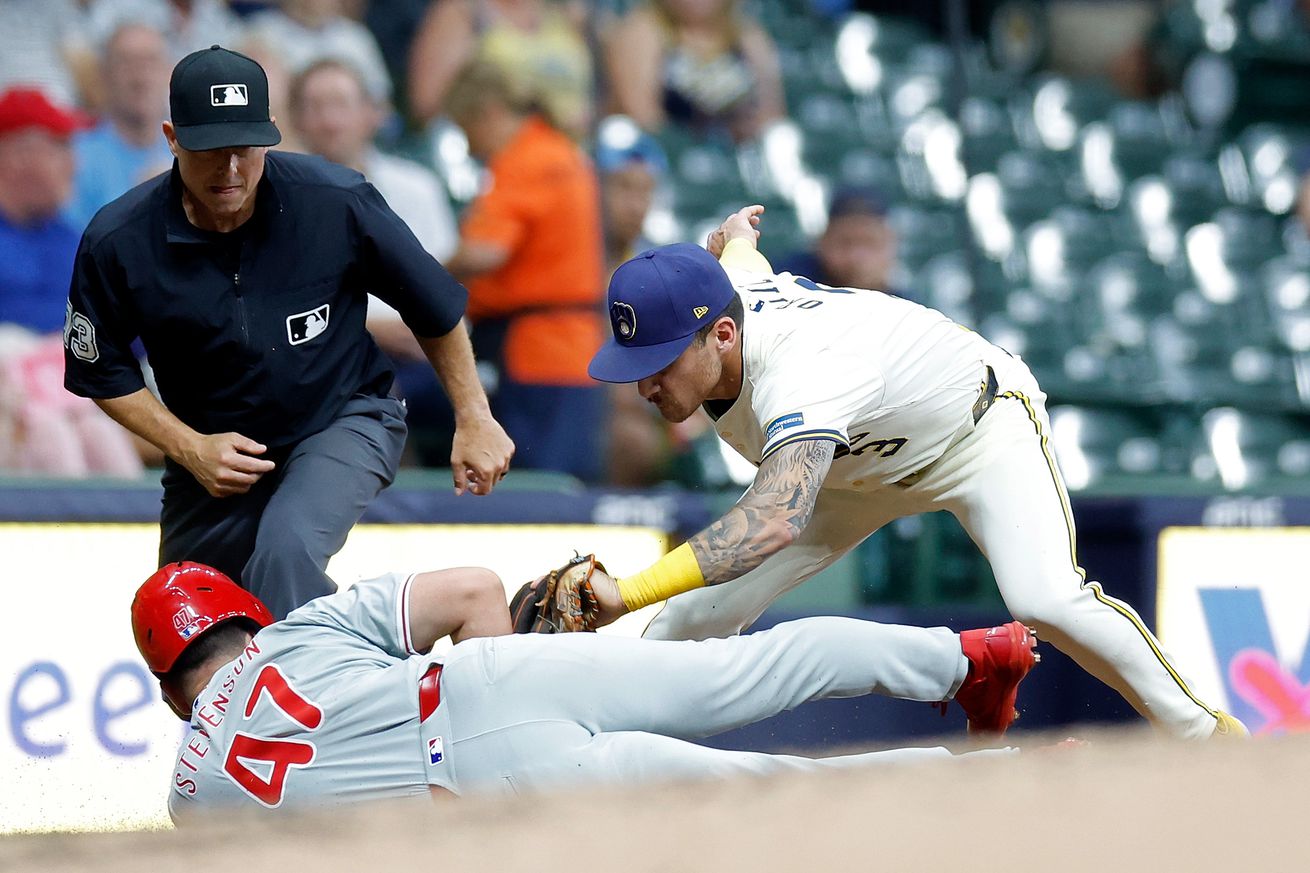
Taking look at some of the Phillies who have donned the number 47 over the years
Since we’re in the dead part of the offseason (unless you’re a Dodgers fan), I’ve decided for no specific reason whatsoever to discuss the history of players who have worn the number 47 for the Philadelphia Phillies.
As you’ll see, players who wear 47 don’t have a grand history of success with the Phillies. That’s not especially surprising, as 47 is generally not regarded as an appealing number for a player to wear. As a result, most 47s have been utterly forgettable players like Michael Mimbs, Pedro Beato, and Erich Uelman. But there have been a few who managed to stand out along the way.
Ted Kleinhans
Rookie pitcher Ted Kleinhans was the first Phillie to wear 47, choosing the number for the 1934 season. But Kleinhans didn’t wear it for very long: He appeared in just five games before being traded to the Reds.
Syl Johnson
One of the players the Phillies received in return from Cincinati was pitcher Syl Johnson who took over the 47 from Kleinhans.
Today in @TheReliefRoom history 1934: RR inductee Syl Johnson is traded by @Reds with Johnny Moore to the @Phillies for Ted Kleinhans, Art Ruble, & Wes Schulmerich. Syl was later inducted into the Oregon HOF and a shrine in my bathroom. Prestigious honors, both of them. pic.twitter.com/OPzCnWgiMy
— TheReliefRoom (@TheReliefRoom) May 16, 2018
Johnson had a solid career for the Phillies, putting up 14.9 WAR across seven seasons. Although he remained with the club until 1940, he switched to 22 in the middle of 1937.
Rollie Hemsley
Hemsley was a five-time All-Star who missed the 1945 season due to military service. He returned to the majors with the Phillies for 1946, but at age 39, his career was essentially over.
Dallas Green
Green is more renowned as the manager of the 1980 World Series champions, but he had two stints as a pitcher as well. He wore 46 the first time around but switched to 47 upon his return. That return only lasted eight games in which he recorded a 9.00 ERA.
He must have preferred the 46, since that’s the number he wore as manager.
Randy Lerch
Speaking of the 1980 team, pitcher Randy Lerch wore the 47 that season. Lerch had a couple of solid seasons for the Phillies, but overall, was worth negative wins over replacement during his seven-year tenure. His most notable accomplishment was winning the game that clinched the division title in 1978.
He was also apparently one of the best hitting pitchers in the game.
Wow. Randy Lerch. I wonder how many pitchers with over 1,000 IP have a higher batting WAR than pitching WAR. Or have a positive career batting WAR and a negative career pitching WAR.
ERA+ of 52No matter – I LOVE this card! pic.twitter.com/VylH0PKaFw
— APBA 1973 Replay ⚾️ (@AlexanderRaine7) October 9, 2023
Larry Andersen
Here’s a recognizable name! The longtime color man for the Phillies wore the number 47 as a rookie for the pennant-winning 1983 Whiz Kids, and ten years later, wore it as a veteran for the 1993 National League champs.
You know him. You love him.
Larry Andersen throws out the ceremonial first pitch ahead of @Toyota Phillies Alumni Day, honoring the 1983 and 1993 NL Championship teams! pic.twitter.com/HSJE7xXNji
— NBC Sports Philadelphia (@NBCSPhilly) August 13, 2023
Bruce Ruffin
Lefthanded pitcher Ruffin looked like a future star when he had a 2.46 in 1986 and finished seventh in Rookie of the Year voting. He never lived up to that early promise and spent the next five seasons alternating between mediocre and bad. Finally, the Phillies lost patience and traded him to the Brewers.
Amaury Telemaco
Telemaco spent parts of six seasons with the Phillies in the early 2000s, often bouncing between starting, relieving, and the minor leagues. He wasn’t very good while wearing 47, and perhaps in an attempt to change his luck, changed to 57 in 2004. He did pitch better with the higher number, but not well enough for the team to retain him after 2005.
If you’d like to see some of his highlights, there is a dedicated Twitter account for that purpose.
Scott Eyre
Needing relief help late in the 2008 season, the Phillies traded for lefthanded reliever Scott Eyre who had fallen out of favor with Cubs manager Lou Pinella, who supposedly couldn’t even remember his name.
Eyre unexpectedly turned into a very solid setup man down the stretch, giving the Phillies a backend of the bullpen that would help carry them to a World Series.
8.7.2008
Phillies acquire Scott Eyre from the Cubs.
Will go 3-0 with a 1.88 ERA in 19 games. pic.twitter.com/I80VfUAtFd
— John Foley (@2008Philz) August 7, 2019
Charlie Morton
The 2016 Phillies were in rebuild mode, and eschewed big name free agents. Instead, they attempted to sign some veteran pitchers who might have some untapped potential. They were correct about Charlie Morton, who did develop into a solid starter. Unfortunately, Morton got injured running the bases four games into his Phillies career, and that breakthrough came with another team.
Howie Kendrick
For 2017, the Phillies tried to bolster their lineup with “competitive hitters” Kendrick and Michael Saunders. Saunders sucked from the start, but Kendrick was solid…or at least he was solid during the brief time he was able to remain healthy. Injuries limited him to 39 games before they traded him to the Nationals, with whom he won the 2019 NLCS MVP.
Cal Stevenson
The most recent wearer of the 47 is outfielder Cal Stevenson. Perhaps he’ll eventually be as forgotten as the likes of Mike Welch (Wore 47 for ten games in 1998), but for now, we’ll always have the Cal Stevenson Game.